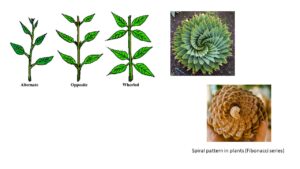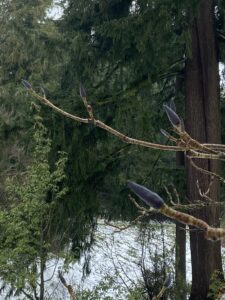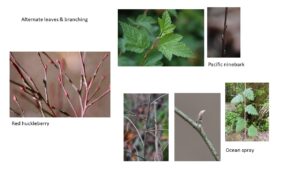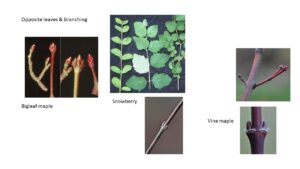Darn that Punxsutawney Phil! More winter to come; maybe he’s to blame for the national mid-February cold-snow-ice wave! I haven’t been out on the trails at Hoyt for more than a week, which is fairly unusual for me. But it’s a great excuse to do a little research and share what I know about winter twig identification.
“Forensic botany” is its own special skill set for plant identification during the winter season when deciduous plants have no leaves. “Phyllotaxis” – Greek for “leaf arrangement” – is the single most important basic plant structure that gives clues about plant family. Most plants have alternate or opposite branching/leaf structure, or, more rarely, whorled leaf/branching structure. Alternate leaves are when branches bear leaves in an alternating pattern up a branch or twig. From a distance, it simply looks like there is one leaf or branch coming out of the branch per node. As it turns out, this alternate leaf arrangement spirals on the branch according to – wait for it! – Fibonacci numbers! This spiral sequence maximizes the exposure of each leaf to the sun. The other most common basic structure is “opposite” leaves or branching, where two leaves or branches come off the same node opposite each other. Most plants are organized by this repeating pattern, with some having whorled structures-which are exhibited in some of the most interesting, lovely plants. This pattern is frequently repeated in not just the arrangement of leaves, but also branching patterns and even the venation on leaves.


In winter, on woody plants without leaves, I look first at branching patterns and then at the arrangement of leaf nodes or leaf scars on branches to see if the plant has an alternate or opposite structure. After looking at the structural pattern, it’s time to get way up close and look at actual leaf buds or leaf scars. Leaf buds are so cool! And tree species have very distinctive buds – a hand lens or loupe helps, but even without one I can see characteristic hairs on the buds and tightly closed or rolled pre-leaves, as well as other evidence. If I look closely at winter buds and am still puzzled about plant family or shrub, I become a detective and look on the ground for dried leaves, nuts, woody cones, or other clues about what the tree might be. That’s the “forensic” part. Helen Gilkey’s OSU monograph (1962), Winter Twigs, remains the best reference for Western Oregon native plant bud and twig identification.
At Hoyt now, many trees and shrubs are getting ready for spring by starting to plump up their leaf buds. Oak family trees are alternate branching and have fat, brown, round buds clustered at the ends of branch tips. Beech trees, alternate branching, have single, reddish brown, very pointy buds at the end of twigs and along twigs. Maple family trees are opposite structured. Bigleaf maples have a large single fat green bud at the branch and twig ends. Ash family and dogwood family trees are also opposite branching. The native Oregon ash has a big fat bud that looks like a chocolate chip at the branch ends. The native cottonwood has a fat oval reddish bud that is sticky, and when rolled between the fingers, gives off a very sweet scent. And, most fun of all, are the magnolia family buds. Magnolias have magnificent flowers and some flower buds look like they are wearing winter fur coats, soft gray and very fuzzy.
I don’t have to visit the Winter Garden to keep track of the season at Hoyt; the trees always have some seasonal signs that they are doing work to get ready for their next job, whether that is bursting into full leaf, preparing for flowering season, or getting ready for winter with their colorful leaves. Get up close and look carefully at the buds to see some interesting signs of spring!


Branching patterns for common native shrubs at Hoyt Arboretum are listed below:
Alternate
Red huckleberry
Oceanspray
Indian plum or osoberry
Pacific ninebark
Roses
Salmonberry, thimbleberry, blackberries
Red flowering currant
California hazelnut


Opposite
Snowberry
Mock orange
Red-osier dogwood
Vine maple
Red elderberry, blue elderberry


About the Author


Photos from:
Claire Carder
Green Seattle – Winter Twig ID Guide
Oregon State University – Landscape Plants
